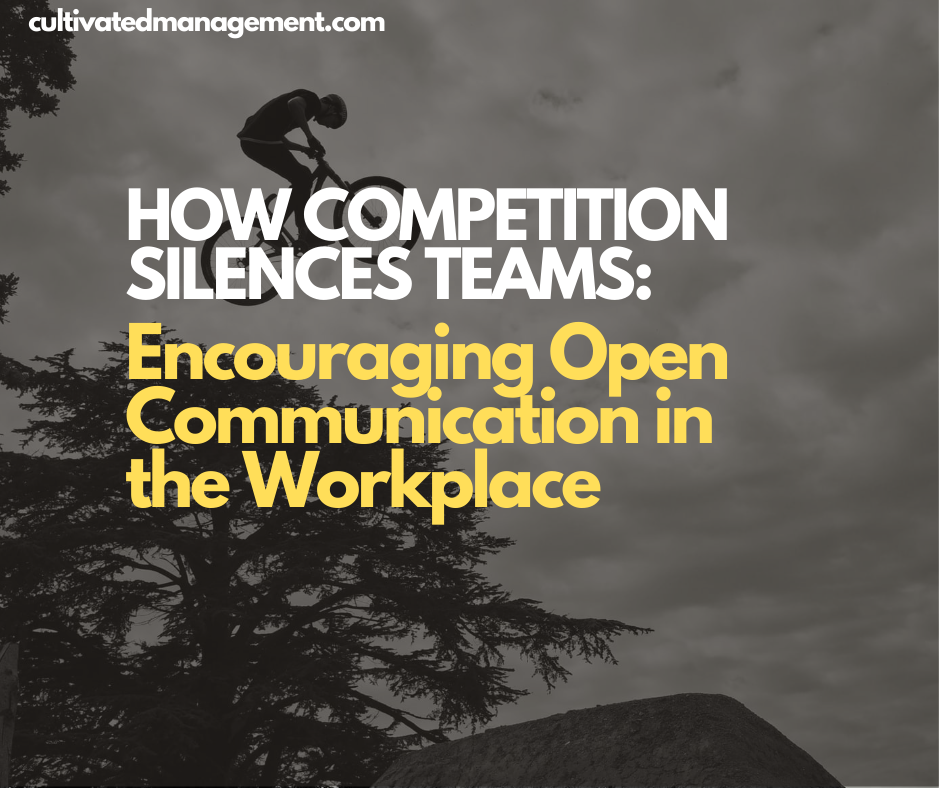
Why Competition in the Workplace Kills Communication
I’m quite competitive in certain aspects of my life. Give me a basketball and I enter pro mode. I have a 19-out-of-20 win streak at Go-Karting. First place is what I focus on.
Even when there are two ATMs next to each other, I’ll race the other person to complete my transaction. I often say “beat you” if I win. Childish? Maybe.
I compete with myself daily. I hold high standards — sometimes unreasonably high — and I like to win in sports, games, fast cars, and life (but not at the expense of other people).
At work? Nada. Zero. No competition between teams, departments, or functions. Fun games and community competitions are fine. Internal competition is not.
Why Competition Breeds Silence
Many leaders don’t realise this, but competition in the workplace silences people.
When your “competitor” is in the room, facts get blurry. Opinions fly. Reporting becomes subjective. Ideas are shot down. Collaboration and cooperation almost disappear. People hide information, avoid asking for help, and deflect responsibility.
👉 See this article on the dysfunction that is Watermelon Reporting
Even competing with other businesses can backfire. I worked at a company where the CEO was obsessed with “crushing the competition.” Our strategy, products, and tactics were dictated by what others were doing. We became carbon copies, competing on price alone. A rapid race to the bottom ensued.
Paul Hawken put it nicely in Growing a Business (aff link):
“We’re not in competition with other businesses; we’re here to offer something that other companies don’t provide.”
Yet the corporate world is full of competitive language: “We’ll destroy the competition,” “We’ll be the best team in the company,” “Crush the opposition.” League tables, rank, perks — everywhere. Leaders assume competition drives growth, urgency, and performance. Often, it does the opposite.
The Impact on Teams
Competition between teams in the same company is particularly damaging. Why? Because everyone is connected.
- When one team pulls in one area, it creates ripples elsewhere.
- When a client complains, other departments deal with the fallout.
- If the wrong product is shipped, someone else fixes it.
Encouraging teams to compete internally is encouraging dysfunction. Despite different roles, everyone is working to deliver value to the customer – and that value will almost certainly cross different functions and boundaries. Internal competition makes that harder.
When competition is present, people rarely speak the truth:
- They won’t admit failures.
- They hide numbers or progress.
- Meetings turn into “attack sessions” on other teams.
- Information becomes vague or outright fabricated.
The result? Poor decisions, frustrated teams, and wasted energy. And lots of Watermelon Reporting.
The Case for Cooperation
Instead of fostering competition, focus on cooperation.
Cooperation doesn’t mean everyone has to like each other. It means people work together to achieve shared outcomes. Key principles:
- Shared goals and outcomes – Everyone knows the target and how their work contributes.
- Equal stakes in rewards – Remove rank, perks, or “winner takes all” incentives.
- Clarity in roles and responsibilities – Everyone understands their work and how it connects to the bigger picture.
- Feedback for counterproductive behaviour – Address people who sabotage others or act competitively.
When these are in place, the behaviours shift:
- People ask for help because they know it benefits the team.
- Honest updates replace “watermelon reports” (green outside, red inside).
- Ideas are shared, refined, and implemented.
- Teams come together to deliver real outcomes.
The Dangers of Internal Competition
Research backs this up:
- Competition between teams can increase stress and drama (Fletcher et al., 2008).
- It can punish employees if manager bonuses are tied to performance (Nikiforakis et al., 2019).
Even with the best intentions, competition creates fear, silence, and misalignment. People focus on beating each other, not on solving customer problems or improving processes.
A Simple Approach
Here’s my view:
- Paint a compelling picture of the future – Make it clear and motivating.
- Align everyone around shared goals – Remove internal competition by ensuring outcomes benefit all.
- Foster cooperation – Force cooperation where needed and make stakes meaningful.
- Focus on value – Encourage outcomes that deliver real value to customers, not just wins over colleagues.
If you do this, you’ll see:
- Teams openly share information.
- People help each other without fear.
- Problems are solved faster and with better solutions.
- Communication flows freely.
- And much less Watermelon Reporting
Internal competition is seductive. It promises urgency, drive, and results. But it comes at the cost of trust, transparency, and collaboration. Cooperation, aligned goals, and shared outcomes create real performance and a positive workplace culture.
Key Takeaways
- Be competitive with yourself, but not with your colleagues.
- Encourage cooperation, not internal rivalry.
- Remove ranks, perks, and other incentives that pit teams against each other.
- Align goals and focus on outcomes that matter to customers.
- When people stop competing internally, communication flows — and decisions get better.
In short:
Competition within a business kills communication. Cooperation, shared purpose, and aligned goals create heat and energy that actually drives results. Everyone is connected; everyone has to work together. Stop competing. Start cooperating.
Bibliography
Nikiforakis, N., Oechssler, J., Shah, A., 2019. Managerial bonuses and subordinate mistreatment. European Economic Review 119, 509–525. https://doi.org/10.1016/j.euroecorev.2019.07.017
Fletcher, T.D., Major, D.A., Davis, D.D., 2008. The interactive relationship of competitive climate and trait competitiveness with workplace attitudes, stress, and performance. Journal of Organizational Behavior 29, 899–922. https://doi.org/10.1002/job.503
